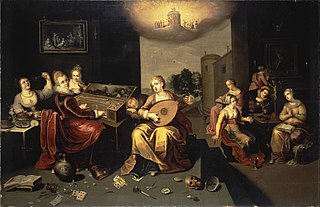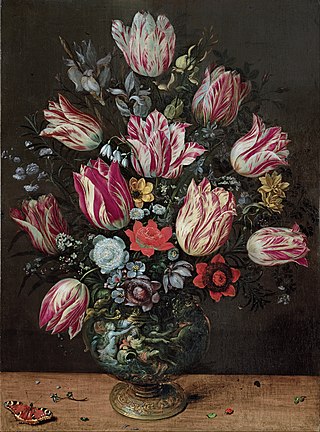
Herentals is a city in the province of Antwerp. The municipality comprises the city of Herentals proper and the towns of Morkhoven and Noorderwijk. In 2022, Herentals had a total population of 28.455. The total area is 48.56 km2 (18.75 sq mi). Saint Waltrude is the patron saint of the city.

Frans Floris, Frans Floris the Elder or Frans Floris de Vriendt was a Flemish painter, draughtsman, print artist and tapestry designer. He is mainly known for his history paintings, allegorical scenes and portraits. He played an important role in the movement in Northern Renaissance painting referred to as Romanism. The Romanists had typically travelled to Italy to study the works of leading Italian High Renaissance artists such as Michelangelo, Raphael and their followers. Their art assimilated these Italian influences into the Northern painting tradition.
The Antwerp School was a school of artists active in Antwerp, first during the 16th century when the city was the economic center of the Low Countries, and then during the 17th century when it became the artistic stronghold of the Flemish Baroque under Peter Paul Rubens.

Flemish Baroque painting was a style of painting in the Southern Netherlands during Spanish control in the 16th and 17th centuries. The period roughly begins when the Dutch Republic was split from the Habsburg Spain regions to the south with the Spanish recapturing of Antwerp in 1585 and goes until about 1700, when Spanish Habsburg authority ended with the death of King Charles II. Antwerp, home to the prominent artists Peter Paul Rubens, Anthony van Dyck, and Jacob Jordaens, was the artistic nexus, while other notable cities include Brussels and Ghent.

Frans Francken the Younger was a Flemish painter and the best-known and most prolific member of the large Francken family of artists. He painted large altarpieces for churches as well as smaller historical, mythological and allegorical scenes. His depictions of collectors' cabinets established a popular new genre of art in the era. Francken often collaborated with other artists, adding figures and narrative elements to scenes created by specialists in landscape, architectural and floral still life paintings.

Abraham Govaerts was a Flemish painter who specialized in small cabinet-sized forest landscapes in the manner of Jan Brueghel the Elder and Gillis van Coninxloo. He was a regular collaborator with other artists who were specialists in specific genres. Govaerts would paint the landscape while these specialists painted the figures, animals or still life elements.

Ambrosius Brueghel was a Flemish painter from the famous Brueghel family of artists. Less prolific and less well-known than a number of his family members, his oeuvre is not very well understood and is believed to comprise Baroque still lifes, garland paintings as well as landscapes.

Frans Francken I or Frans Francken the Elder was a Flemish painter who was one of the principal painters in Antwerp during the Counter-Reformation. He is mainly known for his large altarpieces and allegorical paintings. He was a member of the Francken dynasty of painters that played an important role in the Antwerp art scene in the late 16th century and the 17th century.

Hendrik van Steenwijck II (c.1580–1640) was a Baroque painter mostly of architectural interiors, but also of biblical scenes and still lifes.

Adriaen or Adriaan van Stalbemt or Adriaen van Stalbempt was a Flemish painter and printmaker who is known for his landscapes with religious, mythological and allegorical scenes. He was also a gifted figure painter who was regularly invited to paint the staffage in compositions of fellow painters.

Marten Pepijn was a Flemish painter who was mainly known for his large-scale history paintings and to a lesser extent for his smaller genre scenes.

Frans Francken III (1607–1667) was a Flemish Baroque painter and the best known member of the fourth generation of the Francken family of artists.

Ambrosius Francken I (1544–1618) was a Flemish painter known for his religious works and historical allegories painted in a late Mannerist style. He was a prominent member of the Francken family of artists, which played a very important role in the Flemish art scene from the late 16th to middle 17th century.

Hieronymus Francken I or Hieronymus Francken the Elder was a Flemish painter and an important member of the Francken family of artists. After training in Antwerp, he was mainly active in France, where he became court painter at the French court. His compositions with elegant groups of dancing figures, musicians and courtiers anticipate the development of this genre in the 17th century.

Hieronymus Francken III, was a Flemish Baroque painter and a well known member of the Francken family of artists.

Hieronymus Francken the Younger or Hieronymus II was a Flemish painter and one of the most prominent members of the large Francken family of artists. Along with his brother Frans Francken II he played an important role in the development of new genres in Flemish art in the early 17th century. He was a prolific artist with a wide range who painted religious scenes, allegorical subjects, portraits, fruit pieces, genre scenes, architectural paintings and art galleries.

Andries Daniels was a Flemish painter who was active in Antwerp during the first half of the 17th century. He is known for his flower still lifes and garland paintings, a genre of still life paintings that he helped develop in Antwerp.

Isabella Francken was a Flemish painter who was active in the first part of the 17th century. She was a member of the large Francken family of artists. Only a few works are currently attributed to her. These are history, landscape, and genre paintings, which are in the style representative of the Francken family workshop.
Francken is a Dutch patronymic surname, meaning "son of Frank". People with this name include:

The Parable of the Prodigal Son is an oil painting by the brothers Frans Francken the Younger and Hieronymus Francken II, now in the collection of the Amsterdam Museum. It was created sometime between 1610 and 1620 in Antwerp and was acquired by the Amsterdam art collector Adriaan van der Hoop in 1843, who donated it to the city in 1854. It is on long term loan to the Rijksmuseum.




















